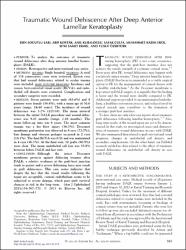| dc.contributor.author | Sarı, Esin Söğütlü | |
| dc.contributor.author | Koytak, Arif | |
| dc.contributor.author | Kubaloğlu, Anıl | |
| dc.contributor.author | Culfa, Şafak | |
| dc.contributor.author | Erol, Muhammet Kazım | |
| dc.contributor.author | Ermiş, Sıtkı Samet | |
| dc.contributor.author | Özertürk, Yusuf | |
| dc.date.accessioned | 2019-10-22T12:09:11Z | |
| dc.date.available | 2019-10-22T12:09:11Z | |
| dc.date.issued | 2013 | en_US |
| dc.identifier.issn | 0002-9394 | |
| dc.identifier.issn | 1879-1891 | |
| dc.identifier.uri | https://doi.org/10.1016/j.ajo.2013.05.014 | |
| dc.identifier.uri | https://hdl.handle.net/20.500.12462/9130 | |
| dc.description | Sarı, Esin Söğütlü (Balikesir Author) | en_US |
| dc.description.abstract | PURPOSE: To analyze the outcomes of traumatic wound dehiscence after deep anterior lamellar keratoplasty (DALK).
DESIGN: Retrospective and interventional case series.
METHODS: SETTING: Single hospital. PATIENTS: A total of 338 consecutive cases were reviewed. Eleven eyes that had wound dehiscence related to ocular trauma were included. MAIN OUTCOME MEASURES: Incidence and causes, best-corrected visual acuity (BCVA), and endothelial cell density were evaluated. Complications and secondary surgeries were recorded.
RESULTS: Seven patients were male (63.6%) and 4 patients were female (36.4%), with a mean age of 30.6 years (range, 24-40 years). The incidence of wound dehiscence was 3.2% (11/338). The mean interval between the initial DALK procedure and wound dehiscence was 9.45 months (range, 2-16 months). The mean follow-up time was 6 years. The most common trauma was a fist blow injury (36.3%). Descemet membrane perforation was observed in 8 eyes (72.7%); lens damage and vitreous prolapse occurred in 2 eyes (18.1%). The final BCVA was 0.51 and was maintained in 4 eyes (36.3%). At the final visit, 10 grafts (90.9%) were clear. The mean endothelial cell loss was 55.8% between before DALK and last visit.
CONCLUSION: Although the intact Descemet membrane protects against dehiscing traumas after DALK, a relative weakness at the graft-host junction tends to persist and a severe deforming force may result in graft dehiscence. This case series indicates that despite the fact that the visual results following the repair are acceptable, corneal endothelium seems to be subjected to severe damage, which puts graft survival chances at risk in the long term. | en_US |
| dc.language.iso | eng | en_US |
| dc.publisher | Elsevier Science Inc | en_US |
| dc.relation.isversionof | 10.1016/j.ajo.2013.05.014 | en_US |
| dc.rights | info:eu-repo/semantics/openAccess | en_US |
| dc.subject | Penetrating Keratoplasty | en_US |
| dc.subject | Graft Dehiscence | en_US |
| dc.title | Traumatic wound dehiscence after deep anterior lamellar keratoplasty | en_US |
| dc.type | article | en_US |
| dc.relation.journal | American Journal of Ophthalmology | en_US |
| dc.contributor.department | Tıp Fakültesi | en_US |
| dc.contributor.authorID | 0000-0002-1720-8065 | en_US |
| dc.identifier.volume | 156 | en_US |
| dc.identifier.issue | 4 | en_US |
| dc.identifier.startpage | 767 | en_US |
| dc.identifier.endpage | 772 | en_US |
| dc.relation.publicationcategory | Makale - Uluslararası Hakemli Dergi - Kurum Öğretim Elemanı | en_US |


















